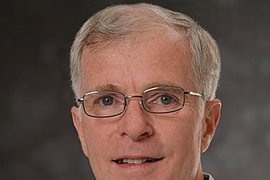The Lunar Laser Communication System (LLCS) received a 2014 R&D Magazine Editor's Choice Award for Information Handling during the 52nd annual R&D 100 Banquet and Awards Presentation, held at the Bellagio hotel in Las Vegas, Nev., on Nov. 7. LLCS, designed and built by Lincoln Laboratory with program oversight provided by the National Aeronautics and Space Administration, was one of three technologies chosen for this honor from among the year's 100 R&D 100 Award winners. Named as the 100 most technologically-significant innovations introduced in 2013, the winners included five other Lincoln Laboratory-developed technologies: Airborne Sense-and-Avoid Radar Panel, Curled Microelectromechanical Switch, Haystack Ultrawideband Satellite Imaging Radar, Localizing Ground-Penetrating Radar, and Wide-Area Chemical Sensor. The Editor's Choice Award represents the highest distinction attainable by R&D 100 Award winners.
Achieving NASA's long-elusive (40-year) goal of deep-space-based laser communications (lasercom), LLCS revealed the possibility of expanding broadband capabilities in future space communications development. Transmission of high-resolution maps of planets, multispectral and hyperspectral images of objects in space, and possibly real-time and high-definition videos will require orders of magnitude higher communications capacity than currently possible with traditional radio-frequency technologies. For years, engineers have recognized that optical communications, because of the very high gain of reasonably sized telescopes and the very wide bandwidth available, has the potential to provide the data rates envisioned for space missions. While several near-Earth lasercom systems have been demonstrated, their approaches do not scale to the extremely long distances needed to explore our solar system.
In October 2013, the LLCS used a pulsed-laser beam to send data from a space terminal aboard NASA's Lunar Atmosphere and Dust Environment Explorer (LADEE) spacecraft to a ground terminal in White Sands, N.M., at a downlink rate six times higher than that achieved by the best radio system ever fielded to the moon and an uplink rate 5,000 times that achieved using radio technology. Lincoln Laboratory built the space terminal and primary ground terminal for this Lunar Laser Communication Demonstration (LLCD), a NASA-led mission to prove the fundamental concepts of lasercom at extremely long distances. LLCS, which delivered error-free performance relaying varying types of data — imagery, video, text — over the 239,000-mile distance between the moon and Earth, demonstrated the longest lasercom link ever created through the turbulent atmosphere.
The small space terminal transmits a 0.5-watt infrared laser signal through its 4-inch telescope toward the ground terminal, while at the same time receiving the uplink signal transmitted from a 40-watt laser transmitted through telescopes at the transportable ground terminal. The downlink beam is received by a novel array of highly sensitive superconducting detectors that measure the individual photons in the beam. Information is carried in both uplink and downlink laser beams using very-high-speed patterns of laser pulses. LLCS incorporates several innovative technologies to provide high-data-rate lasercom transmission over huge distances through Earth's atmosphere: advanced photon-counting receivers, pulsed transmitters, error-correction codes with their optimum decoders, channel data interleaving, and synchronization headers.
The specific designs of LLCS are useable for any future missions at lunar distances and can be scaled to support missions at slightly longer distances. With the addition of different hardware, these designs have been shown to scale to planetary distances.
The three Editor's Choice awardees — LLCS; the SaTo (for "safe toilet") Hygienic Toilet Pan, developed by American Standards; and the Apollo Platform for High-Performance Computing, co-developed by Hewlett Packard and the National Renewable Energy Laboratory — were publically announced for the first time at the conclusion of the R&D 100 Awards ceremony. Two additional awards were presented during the ceremony: the Scientist of the Year Award to Karl Deisseroth, one of the United States' leading optogenetics researchers, and the Innovator of the Year Award to Hugh Herr, head of the biomechatronics research group at MIT Media Lab.
Earlier in the day, winning teams showcased their technologies and fielded questions from other R&D 100 winners, media personnel, and the general public at an exhibition.
LLCS is the second Lincoln Laboratory-developed technology to receive an R&D Magazine Editor's Choice Award; in 2011, the Multifunction Phased Array Radar Panel was chosen for this distinction.









